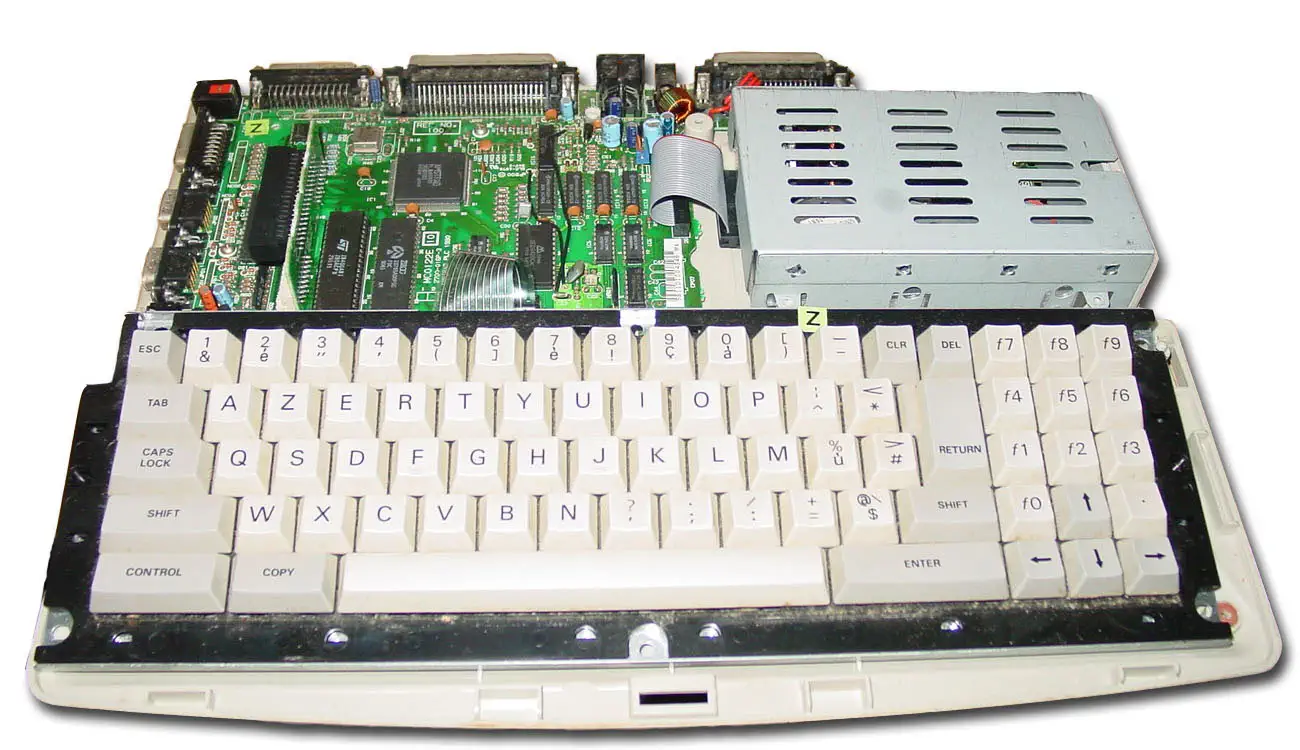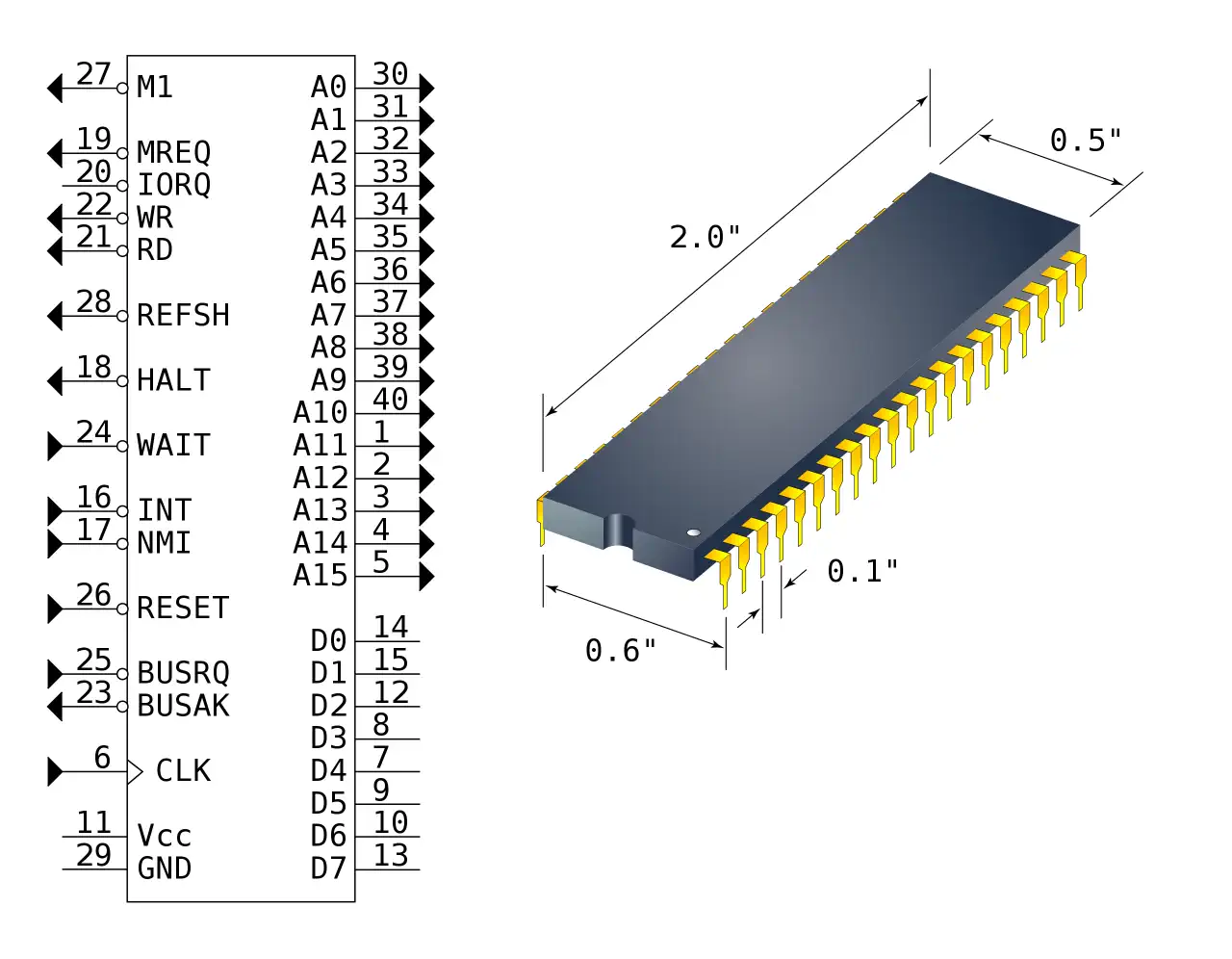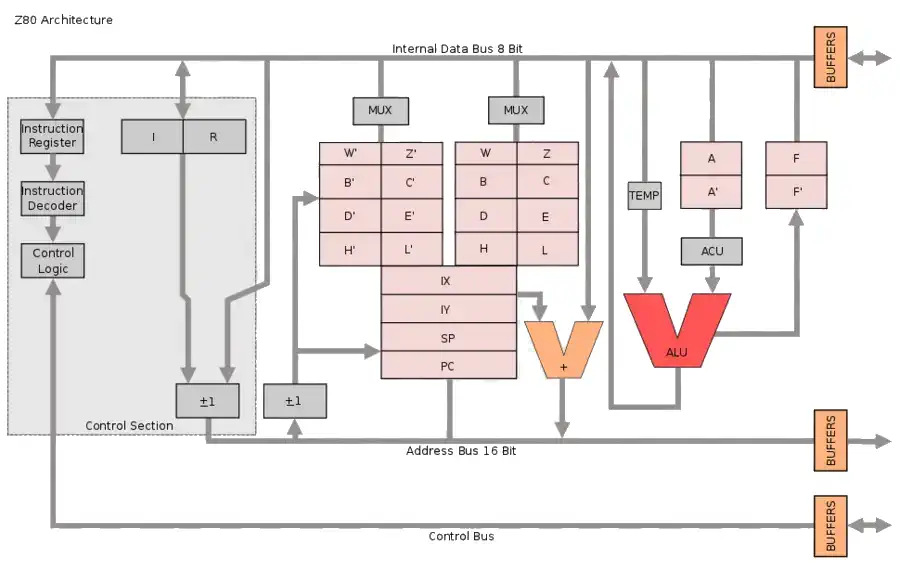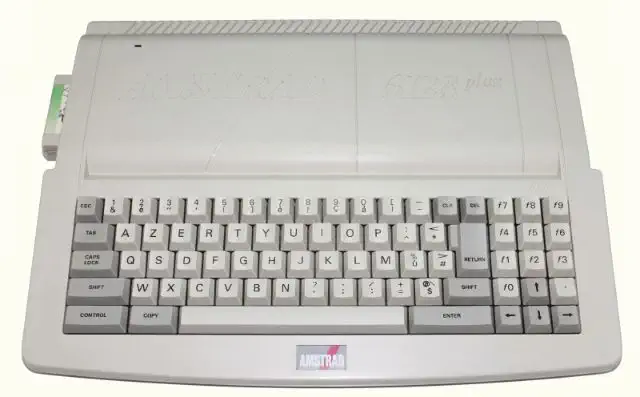The Amstrad CPC 6128 Plus
The Amstrad 6128 Plus is based on the architecture of the original Amstrad CPC6128 but in a completely redesigned modern case. It was an effort to re-vamp the brand and create a computer that was aesthetically more pleasing than the large rectangular brick of the CPC6128.

Amstrad CPC Plus
In 1990, confronted with a changing home computer market, Amstrad decided to refresh the CPC model range by introducing a new range variantly labeled CPC Plus.
The main goals for the Plus range were:
- Enhancement to the existing platform
- Restyled case with a modern look
- Support for cartridge games
The redesigned video hardware allows for various upgraded features
- Hardware Sprites in 15 colors
- Soft scrolling
- Enhanced color palette: extended to 31 out of 4096.
Sound was also enhanced, including DMA transfer, allowing more complex sound effects with a significantly reduced processor overhead. Other hardware enhancements include the support of analogue joysticks, 8-bit printers, and ROM cartridges up to 4 Mbits.
The new range of models was intended to be completely backwards compatible with the original CPC models. Its enhanced features are only available after an obscure unlocking mechanism has been triggered, preventing existing CPC software from accidentally invoking them.
Despite the significant hardware enhancements, many viewed it as outdated, being based on an 8-bit CPU, and it failed to attract both customers and software producers who were moving towards systems such as the Commodore Amiga and Sega Mega Drive which was launched a few short months after the plus range. The plus range was a commercial failure, and production was discontinued shortly after its introduction in 1990.
Amstrad CPC Computers
Amstrad was known for cheap hi-fi products but had not broken into the home computer market until the CPC 464. Their consumer electronic sales were starting to plateau and owner and founder Alan Sugar stated "We needed to move on and find another sector or product to bring us back to profit growth". Work started on the Amstrad home computer in 1983 with engineer Ivor Spital who concluded that Amstrad should enter the home computer market, offering a product that integrated low-cost hardware to be sold at an affordable "impulse-purchase price". Spital wanted to offer a device that would not commandeer the family TV but instead be an all-in-one computer with its own monitor, thus freeing up the TV and allowing others to play video games at the same time. Bill Poel, General Manager of Amsoft (Amstrad's software division), said during the launch press release that if the computers were not on the shelves by the end of June "I will be prepared to sit down and eat one in Trafalgar Square".
Many programs and peripherals were developed for the CPC computers. Amstrad's Operating System was AMSDOS. This OS is embedded in Basic using so-called RSX commands starting with |, but it could not format disks, for that you needed a special application. The 464 also could use CP/M 2.2 or 3.0 when used with an external Floppy disk unit (3" Hitachi, 180 KB / face). A lot of great CP/M software was adapted for the Amstrad CPC.
About 42 KB RAM was available for the user, the video memory and the ROM were mapped on the same addresses with a dedicated chip to switch the memory banks automatically.
The first Amstrad CPC prototype (called "Arnold", which gave the name ROLAND (Arnold acronym) to several CPC games) was built around a 6502 processor and then changed to a Z80 late in the computer’s development. A few months later, the CPC series would be completed with a computer which offered a built-in floppy disk unit: the CPC 664.
The CPC series are powered by the Zilog Z80 processor after the original attempts to use the 6502 processor, being used in the Apple II amongst many other 8-bit computer families, failed. The Z80 runs at 4 MHz, has 64K of memory and runs AMSDOS, Amstrad's own OS. The unit includes a built in tape drive and the choice of a colour or green monochrome monitor.
Video Modes
Normal Video Modes
- Mode 0 - 160x200 in 16 colors
- Mode 1 - 320x200 in 4 colors
- Mode 2 - 640x200 in 2 colors
- Mode 3 - 160Ãâ€â€200 in 4 colors*
Each color can be chosen from a palette of 27 colors total. The dimensions in pixels given could be raised with clever use of FullScreen Trick (often dubbed erronuously as overscan mode). This then allows with a video memory of 24 KB (approximately) to have alternate video modes.
Alternate Video Modes
- Alt Mode 0 - 192x272 in 16 colors
- Alt Mode 1 - 384x272 in 4 colors
- Alt Mode 2 - 768x272 in 2 colors
Amstrad CPC ASIC video circuit.
The later Amstrad CPC line of computers, starting with the 6128 and later models, used a custom-designed ASIC (Application-Specific Integrated Circuit) known as the "Gate Array" to simplify and streamline the hardware design. Amstrad introduced the Gate Array ASIC in the CPC line to handle various system functions that would otherwise require multiple discrete chips, helping to reduce manufacturing costs and improve reliability while enhancing the system's graphics and memory control capabilities.
The Gate Array managed several key tasks, such as controlling video output, managing system timing, and handling memory access. This chip was responsible for selecting the CPC’s video modes, which offered a range of color and resolution combinations: Mode 0 for low resolution with up to 16 colors, Mode 1 for medium resolution with 4 colors, and Mode 2 for high resolution with 2 colors. By centralizing video processing in the Gate Array, the CPC could render smooth graphics with minimal strain on the main Z80 processor. The chip also allowed the CPC to use a standard RGB monitor connection, providing a clearer display compared to contemporaries that often relied on composite video output.
In addition to video control, the ASIC facilitated efficient memory management by coordinating between RAM and the system's various components. This streamlined architecture was crucial for the CPC’s performance, enabling it to compete with other 8-bit systems like the Commodore 64. The Gate Array ASIC made the CPC’s hardware simpler, more efficient, and affordable, contributing to the system's success in Europe and helping the CPC series stand out in a crowded home computer market. This approach allowed Amstrad to offer a powerful, cost-effective computer with graphics capabilities that attracted both hobbyist programmers and gamers.
CPU View - Zilog Z80 Family
The Z80 quickly became popular in the personal computer market, with many early personal computers, such as the TRS-80 and Sinclair ZX80, using the Z80 as their central processing unit (CPU). It was also widely used in home computers, such as the MSX range, SORD, and the Amstrad CPC, as well as in many arcade games. Additionally, it was also used in other applications such as industrial control systems, and embedded systems. The Z80 was widely used until the mid-1980s, when it was gradually replaced by newer microprocessors such as the Intel 80286 and the Motorola 68000.
The Z80 microprocessor was developed by Zilog, a company founded by Federico Faggin in 1974. The Z80 was released in July 1976, as a successor to the Intel 8080. It was designed to be fully compatible with the 8080, but also included new features such as an improved instruction set, more powerful interrupts, and a more sophisticated memory management system.
The Z80 quickly became popular in the personal computer


320x200, 4 colors
640x200, 2 colors
4096 color palette Best Color 16 out of 4096 colors Graphics 160x200 in 16 out of 4096 colors Sprites 16 16x16 sprites in 15 additional colors System OS Amstrad BASIC Storage Internal Disk Drive, External Tape, ROM Cartridges

